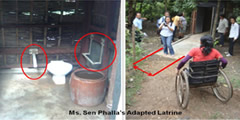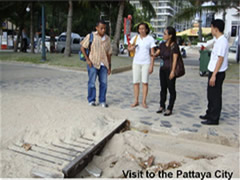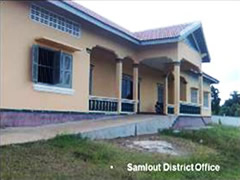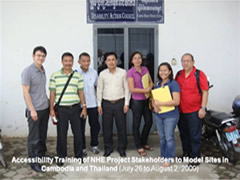- Home
- Technical Cooperation Projects
- Index of Countries
- Asia
- Philippines
- Creation of Non-Handicapping Environment for Persons with Disabilities in the Rural Areas
- Project Activities
- Accessibility Training in Cambodia and Thailand
Accessibility Training in Cambodia and Thailand
As part of empowerment of the implementers of the NHE Project, stakeholders went to Cambodia and Thailand from July 26, 2009 to August 2, 2009 for seven (7) days Accessibility Training of Non-Handicapping Environment (NHE) Project Stakeholders to Model Sites in Cambodia and Thailand.
 Adapted Latrine in Cambodia
Adapted Latrine in Cambodia
The participants were composed of five (5) representatives of the NHE Project Stakeholders from the two (2) pioneering municipalities as follows:
- Representative of the NCDA – Acting Chief, Programs Management Division
- Representative of United Architects of the Philippines (UAP) – Deputy Chairman, Committee on Accessibility (member of the NHE Core Group)
- Representatives of Local Government Unit (LGU), Opol – Municipal Councilor
- Representative of LGU, Opol - Municipal Engineer.
- Representative of LGU, New Lucena – Municipal Planning and Development Coordinator, together with one (1) JICA Expert/NHE Chief Advisor.
With regard to "accessibility" for PWDs, a barrier to built environments is one of the main issues in the Philippines especially in the rural areas. If accessibility is taken into account during the conception phase of building design, it may cost no more than one percent (1%) of the total cost of the building. However, accessibility is often not considered at the beginning, and modification of buildings after the establishment is more costly. In order to respond to this constraint and to enhance efficiency and sustainability, it is proposed to include accessibility features in the beginning of building design and to utilize local materials to implement. In particular, accessibility should be promoted in developing countries by using indigenous materials which are locally available and financially affordable.
Training Objectives
- To deepen insights on how to create an accessible environment in rural areas;
- To enhance technical knowledge on accessibility of the built environment in the preparation of:
- Technical Drawings
- Fabrication of accessibility features using local or indigenous materials
- Estimating Cost of access features
- To learn the activities that are relevant in the promotion of Non-Handicapping Environment and in the empowerment of Persons with Disabilities in developing countries.
 Pattaya City in Thailand
Pattaya City in Thailand
Training Contents
Expected output of the project was to enhance the capacity of officials of NCDA, Disabled Persons' Organizations (DPOs), municipal local government units, line agencies and civil society organizations to address social and physical accessibility. In this connection, Accessibility Training of NHE Project Stakeholders to Model Sites in Cambodia and Thailand" is planned, targeting five (5) Filipinos engaged in the NHE Project from organizations mentioned above.
As a main objective, they visited model sites of accessibility in Cambodia and Thailand in order to learn how to create an accessible environment using local materials especially in the rural setting. Also, other relevant organizations (e.g. Disability Action Council in Cambodia, APCD in Thailand) were visited so that the participants could gain insights on how to coordinate and collaborate with other organizations for promoting accessibility.
Based on the network of the project and the information from stakeholders, two areas, Battambang in Cambodia as a rural model and Pattaya in Thailand as an urban model are identified. In Battambang, Handicap International (HI) France has implemented activities to create accessible features and establishments using indigenous materials and developed manuals on "How to Build an Accessible Environment in Developing Countries." On the other hand, Pattaya is known as an accessible city with beaches, where its local government unit attempts to develop accessible tourism. As Opol and New Lucena also try to promote both accessibility and tourism, Pattaya can be a good example for them to learn from.
Since the HI France's practice in Battambang is quite unique and Pattaya city's achievements in accessibility are remarkable, there are no similar sites available for the participants to visit and study in the Philippines.
 Samlout District Office in Cambodia in Thailand
Samlout District Office in Cambodia in Thailand

- About JICA
- News & Features
- Countries & Regions
- Our Work
- Thematic Issues
- Types of Assistance
- Partnerships with Other Development Partners
- Climate Change / Environmental and Social Considerations
- Evaluations
- Compliance and Anti-corruption
- Science and Technology Cooperation on Global Issues
- Research
- JICA Development Studies Program / JICA Chair
- Support for the Acceptance of Foreign HRs / Multicultural and Inclusive Community
- Publications
- Investor Relations
